 (300k
audio)
(300k
audio)
According to the Tibetan Book of the Dead, after you have met your Fate in a given World among the Many-Worlds, and your Physical Life therein is over, your Spirit, or Consciousness, encounters the
 (300k
audio)
(300k
audio)
According to the Tibetan Book of the Dead, after you have met your Fate in a given World among the Many-Worlds, and your Physical Life therein is over, your Spirit, or Consciousness, encounters the
The white bar represents the Bardo of Clear Light, the simple clear transparent Realm that encompasses all of the Many Worlds of Many-Worlds Quantum Theory at the level of Simplex Physics above the Planck Energy.
The Talmud Chagigah says, "... Ben Azzai glanced towards the Divine Presence and consequently died. ... His soul became so enraptured by the supernal realities it experienced in the Merkavah state that it formed an intense connection with them. Ben Azzai's soul gazed at the brilliantly clear light and it separated from its body, as well as from all bodily functions. It chose the serenity of Heaven over the vicissitudes of our earth and never returned again (Maharsha, citing "an ancient book"; see also Kuzari 3:73). ...". (From Talmud Bavli / Tractate Chagigah, The Gemara, The ArtScroll Series / Schottenstein Edition, Mesorah Publications Ltd. (1999) 14b 3)
If you recognize it and merge with it, you are at one with the Realm of the Many Worlds.
If you do not recognize the Realm of the Many Worlds, you pass on to the next Bardo.
The yellow bar, and the three red, green, and blue bars, represent the Bardo of Luminous Dharmata.
The yellow bar represents the first level below the clear transparent realm of Simplex Physics above the Planck Energy. Really, the yellow bar should be a white color that is not clear or transparent, but in the image I have used white to represent clear, so I used yellow to represent a white color that it not clear or transparent. In terms of the D4-D5-E6-E7-E8 VoDou Physics model, this is the level of the Spin(8) physics model before dimensional reduction from 8-dimensional octonionic spacetime. The D4-D5-E6-E7-E8 VoDou Physics model is based on the Clifford Algebra Cl(8) whose dimensionality is 256 = 16x16, the same as the FA.
The three red, green, and blue bars together represent the second level below the clear transparent realm of Simplex Physics above the Planck Energy. The three bars represent the associative triangles of the octonions, and the three space dimensions of 4-dimensional spacetime of the D4-D5-E6-E7-E8 VoDou Physics model after dimensional reduction.
If you can recognize the Realm of the Many Worlds at any of these levels, then you can merge with it, and you will be at one with the Realm of the Many Worlds.
If you still do not recognize the Realm of the Many Worlds after passing through these levels, then you do not merge with the Realm of the Many Worlds.
If you are able to learn and improve yourself by being reborn in cycles of rebirth, then you might be reborn in cycles of rebirth until you learn enough to merge with the Realm of the Many Worlds;If your soul is not harmonious enough to improve in cycles of rebirth, then your soul must be disintegrated and reassembled, together with parts of other disharmonious souls, in more harmonious forms, a process like purification by the fire of Gehinnom through which souls pass to enter Gan Eden.
The levels are similar to Chakra Colours ( see for example www.threeheartscompany.com/chakra.html ): Violet - Crown - Infinite Oneness with G-d. Indigo - Third Eye - Intuition. Blue - Throat - Verbal Truth. Green - Heart - Emotion. Yellow - Solar Plexus - Digestion. Orange - Sacral - Procreation. Red - Base - Ground to Physical Plane. All of which unite to form White Light, and Transcend to Transparency.
The Five Elements correspond to the 4 vectors and the scalar of Cl(4).
The Three Realms correspond to the 3 vectors of Cl(3), leading to the octonions.
Yin and Yang correspond to the 2 vectors of Cl(2).
Tai Ji corresponds to the 1 vector of Cl(1).
The Tao corresponds to Cl(0).
These may be symbolized by the Faravahar of the monotheistic religion founded by Zarathustra some of whose ceremonies involve fire/light stimulation of the mind.
There are interesting correspondences between Jewish Kabbala, Torah, and Talmud, and Chinese Buddhism and Taoism. A book that discusses some such correspondences is The Jew in the Lotus, by Rodger Kamenetz, HarperCollins 1995.
There is an interesting correspondence between the I Ching and the 16 tetragrams of the IFA, and the Arabic Ilm al-Raml, or the Science of the Sands, that was supposed to have been introduced by Idris, the third prophet of Islam (after Adam and his son Shith) who lived in Egypt before the time of Noah and the flood.
LAO ZI (the Old Child who was his own mother) founded TAOISM and wrote the 3x3x3x3 = 81 passages of the Dao De Jing.
According to Lao Zi, wisdom is to conform to the rhythm of the universe and so to wander freely among the 10,000 Beings.
ZHUANG ZI:
Life and death are not in opposition but merely two aspects of the same reality, part of the universal transformations of everything into everything. At death, humans go back into the great weaving machine:
thus all beings issue from the Loom and return into the Loom.
To describe Universal Transformations, use Many-Worlds Quantum Theory. In it. the vacuum (Qi) is active, so that there is no such thing as nothingness.
According to the 1076 AD work Cheng Meng of Chang Tsai: "When one knows that the great void is full of chhi [Qi], one realizes that there is no such thing as nothingness. ... How shallow were the disputes of the philosphers of old about the difference between existence and non-existence; they were far from comprehending the great science of pattern-principles (Li)."
The basic structure of Qi might be represented by the state of a Wei Qi board with stones, while the pattern-principles (Li) by which the next Wei Qi move is determined might be represented by the I Ching and the Tai Hsuan Ching as though the I Ching and Tai Hsuan Ching show how to move in Wei Qi. This may be related to the HyperDiamond Feynman Checkerboard picture of the D4-D5-E6-E7-E8 VoDou Physics model, and to a connection between Randomness and Consciousness.
Particles that we observe, such as Electrons, Neutrinos, Protons, and Pions, have Compton Radius Vortex structures related to a hydrodynamic interpretation of Bohm Quantm Theory.
The action of the vacuum (Qi) is in accord with the science of pattern-principles (Li). At all levels, the interactions follow the principles of Zhen-Shan-Ren.
At the level of human physical science, the laws are manifested as the laws of physics, as can be described by the D4-D5-E6-E7-E8 VoDou Physics model, in which events are described by Cramer's transaction theory. The probability of any event of interaction is a transaction between an amplitude from the past, looking like one helix, corresonding to Yang, and an amplitude from the future, a mirror-image helix, corresponding to Yin.
According to the Huai Nan Tzu: "Yang is born at the cyclical sign Tzu [North, or midnight]. Yin is born at the cyclical sign Wu [South, or noon]."
The resulting Yin-Yang interactions produce the physics of the D4-D5-E6-E7-E8 VoDou Physics model and look like Double Helix structures, the same structure we material beings use to transmit genetic information. Genetic codes are related to the I CHING.
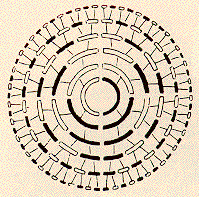
The 8x8 = 64 hexagrams of the I Ching can be seen in the Clifford algebra Cl(0,8).
The spinors of Cl(0,8) are seen in the 9x9 = 81 tetragrams of the Tai Hsuan Ching and their related Magic Cube with 9x9x9 = 729 entries.
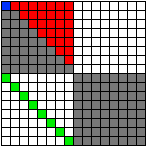
The 28 pairs of unlike trigrams are the 28 D4 bivectors, and

also the 28 Celestial Palaces, or constellations.
The 28 constellations, or 28 Hsiu, repesent 4 heptagons of 7 vertices each, as in this diagram by David B. Kelley:
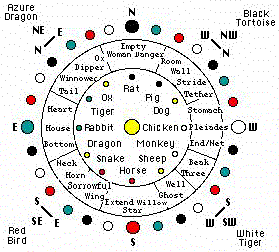
The 12 zodiacal animal signs correspond to the 12 branches which, along with 10 stems, are 22 elements that make up a 12x10 = 120-element cycle of Stem-and-Branch pairs that has a periodicity of 60 elements. A set of 7 Hsiu is related to the 12 zodiacal branches as the 7 white piano keys are related to the 12 keys of an octave. The Hsiu of the 8 directions are: 1 Horn Spica - Arcturus - Big Dipper 5 Heart Antares 8 Southern Dipper Center of Milky Way 11 Void Sad-al-sud (beta Aquarii) 15 Stride Pisces - M31 18 Mao Pleiades 22 Eastern Well Rim of Milky Way 25 Bird Alfard (alpha Hydri) Hsiu 9, Cowboy, contains Altair and Vega, separated by the Northern Milky Way. Hsiu 23 contains the 4-star box of Cancer, enclosing the open cluster Praesepe, representing a Ghost in a Carriage. As stated by Ssu Ma Ch'ien: The 28 Hsiu preside over the 12 provinces; the 7 Stars of the Big Dipper rule over all; this knowledge is very ancient.
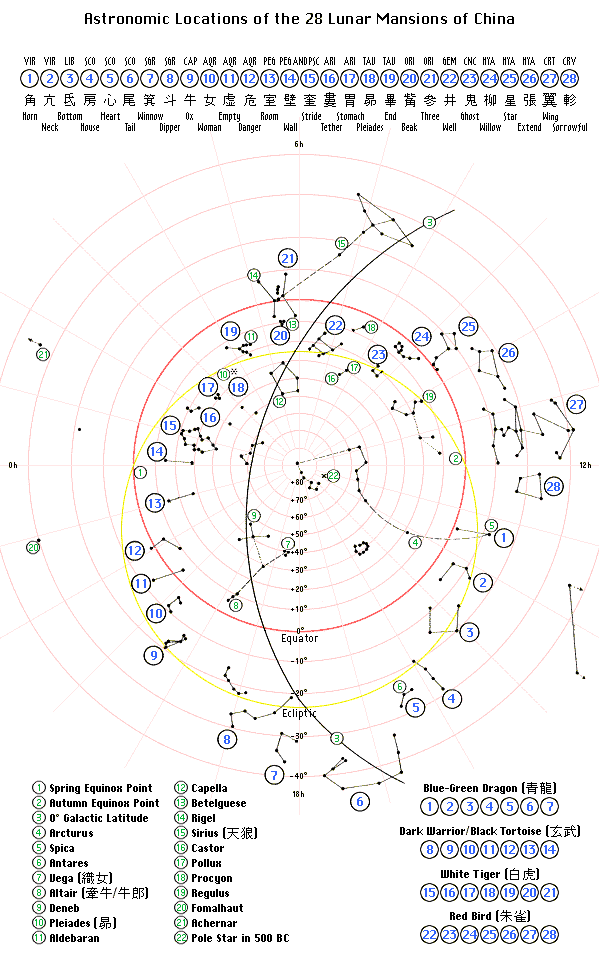
As shown in the above chart prepared by David B. Kelley, Hsiu 1-14 are the Eastern and Northern Palaces. Hsiu 15-28 are the Western and Southern Palaces. In this Lo Pan, the second circle is made from the 7 stars of the Big Dipper plus two assistants, and the outer circle has the 28 Hsiu.
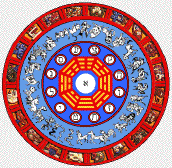
David B. Kelley has compared the 28 Chinese Hsiu with the 28 Nakshatra of India, the 28 Arabian Manazil, and the 28 Babylonian Houses. Further, he compared the 28 Chinese Hsiu with the 29-letter Ugaritic alphabet, with the letters 'a and 'u identified. Still further, he compared the 12 Chinese astronomical provinces with the 12 simple letters of the 22-letter Hebrew alphabet, and placed at the center one of the 3 Elementary Hebrew letters, aleph. His outer ring shows 20 day names of the Aztec zodiac. The Mesoamerican 20 day names, when combined with 13 numbers in the same way as Chinese Stem-and-Branch pairs, make up a 20x13 = 260 day Mayan cycle. The Great Tzolkin of 46 Tzolkins = 11,960 days reconciles the eclipse cycle with the 260-day Tzolkin cycle. The Mayans related the 260 day cycle to the 365 day year, getting a 260x365 = 94,900 day cycle, with 52x365 = 18,980 day = 52 year periodicity. The Mayans also used a 20x18 = 360 day year, which, when related to the 20x13 = 260 day period, makes up a 13x18 = 234 day cycle, which is about twice the solar day on Venus. The Egyptians also used a 360 day year, represented by 36 decans, or zodiacal star configurations, of about 10 degrees each, located south of the plane of the ecliptic. The Egyptians also had about 25 star constellations, some of which include Orion, Sirius, and the 7 stars of the Big Dipper. Just as the 7 Stars of the Big Dipper rule over the 28 Hsiu, the 7 imaginary octonions generate the 28-dimensional Lie algebra Spin(8), whose three 8-dimensional representations are related by triality in such a way as to produce the Freudenthal-Tits Magic Square. 28 is intermediate between the 27.3 day sidereal period of the Moon and the 29.5 day synodic period of the Moon. The 29.5 day synodic period of the Moon, multiplied by the number of days in Earth's year, is close to the 29.5 year sidereal period of Saturn. The sidereal rotation period of the surface of the Sun ranges from about 25 days at the equator to about 35 days at the poles. The synodic periods range from about 27 to 39 days. It takes about 88 days (the sidereal period of Mercury) for the rotating equatorial region of the Sun to "lap" the polar region. The sunspot half-period of 11 years is roughly the 11.86 year sidereal period of Jupiter. The sidereal periods of the planets in terms of half a Mercury year, are, very roughly (i.e., within a few percent): Mercury 2 Venus 5 Earth 8 Mars 16 = 8x 2 asteroids 32 = 8x 4 (mostly from 8x3 to 8x6) Jupiter 96 = 8x 12 = 8x3x4 = 24x4 Saturn 224 = 8x 28 = 8x7x4x1 Uranus 672 = 8x 84 = 8x7x4x3 Neptune 1,344 = 8x168 = 8x7x4x6
The 8-fold Periodicity Theorem for real Clifford Algebras is Cl(p,q+8) = Cl(p,q) (X) R(16) (where (X) is the tensor product and R(16) is the 16x16 real matrix algebra). Also, Cl(p+8,q) = Cl(p,q) (X) R(16). Week 105 by John Baez describes an 8-sided Clifford Clock designed by Andrzej Trautman that shows what types of matrices, Real, Complex, or Quaternion, are used in the Clifford algebras: Cl(0,0) Cl(0,1) Cl(0,2) Cl(0,3) Cl(0,4) Cl(0,5) Cl(0,6) Cl(0,7) R C Q Q+Q Q C R R+R By periodicity, and the relations Cl(p+1,q) = Cl(q+1,p) and Cl(p,q) = Cl(p+4,q-4), you can use the Clifford Clock to see what type of matrices are used in any Clifford algebra Cl(p,q). The Clifford Clock is related to the 8 trigrams arranged in an order corresponding to the sequence of binary numbers 0,1,2,3,4,5,6,7 (clockwise) or 0,7,6,5,4,3,2,1 (counterclockwise). The Clifford sequence is different from the traditional Earlier Heaven and Later Heaven sequences, which are, respectively, in binary notation, 0,1,2,3,7,6,5,4 (counterclockwise) and 2,4,3,6,5,0,1,7 (counterclockwise). The Later Heaven sequence is the inner circle of this Lo Pan. Clifford periodicity and homotopy periodicity are closely related.
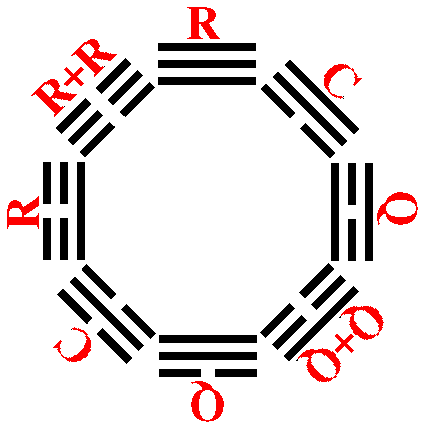
The 8-fold periodicity was anticipated by a creation myth of the Hermopolitan Egyptians: I am One that transforms into Two, I am Two that transforms into Four, I am Four that transforms into Eight, After this I am One again. Hermopolis was known as Khmunu, the City of the Eight, for the Ogdoad of Eight Gods which embodied the inchoate world before creation. The oldest god is Nun, the primeval water of chaos, the father of the Sun God Ra. The Temple at Luxor was designed to represent the Ogdoad, and shows connections with Tarot, the mathematics of the D4-D5-E6-E7-E8 VoDou Physics model, and sedenions. The post-creation deity worshipped at Khmunu was Thoth, god of learning, who was called by the Greeks Hermes Trismegistos, who was identified with the Islamic prophet Idris, also known as Enoch, who appeared between the prophets Adam and Noah and lived most of his 365 years in Egypt, teaching people how to build cities and to write and to sew and to use the Science of the Sands (Ilm al-Raml), which is similar to the I Ching but used 16 Tetragrams which were preserved from the Global Early Civilization as the FA of the Fon people of Benin (Dahomey). The Egyptian glyph MES, meaning birth, is the root of the Greek word mousike, which is the root of the word music. According to Hermes Trismegistos: ... the true knowledge of music is nothing other than this: to know the ordering of all separate things and how the Divine Reason has distributed them; for this ordering of all separate things into one, achieved by skilful reason, makes the sweetest and truest harmony with the Divine Song.
In China, Daoism has 8 Immortals:
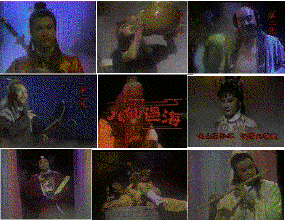
Luu Dongbin Tieguai Li Zhongli Quan Zhang Guolao Lao Zi He Xiangu Cao Guojiu Lan Caihe Han Xiang
Luu Dongbin failed his examination to become an important government official. The failure having freed him from bureaucratic encumbrances, he became an immortal. The symbol of Luu Dongbin is his sword. Here Luu Dongbin sees Le Rayon Vert:

Daoist Immortals (hsein = human mountain) are creatures of light, using mirrors in mountain caves to show wise humans their secrets. Caves were also used by Maya Shamans. In caves, stalactitic ores can form from mineralized solutions dripping from cave ceilings.
Gora Belukha, 14,783 feet, the highest Altai Mountain, correspond to the Chinese Kunlun Shan, home of Xi Wang Mu, the Queen of the West,
and to the Indian Su Meru (although many in India regard Mount Meru as being in the Himalayas), home of Indra, which was described by Pingala about 200 BC as being the mathematical Binomial Triangle, which Pingala used to describe the number of forms of long or short syllables that can be formed from a given number of syllables:
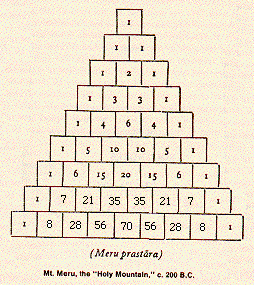
Such a mountain is represented in Buddhist architecture by a dome, such as that of the Basilique du Sacre Coeur de Montmartre in Paris.
Looking East at dawn on 9 March 1997 from the top of Gora Belukha you would see
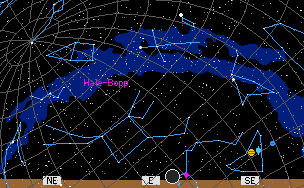
In Korea, mountain gods are called Sansin and often represented by tigers.
Interpenetrating Pairs of Mt. Meru Triangles form a Mogan David.
/\ ____/__\____ \ / \ / \/ \/ /\ /\ /__\____/__\ \ / \/
A Mogan David expands to form a Sri Yantra, a Vedic madala:
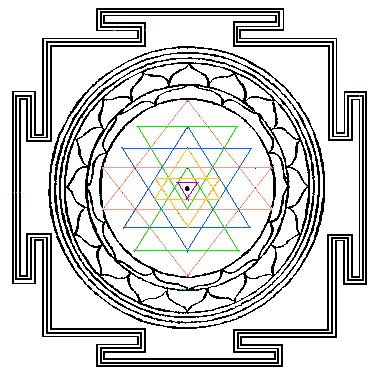
This Sri Yantra is a more symmetrical modification of Sri Yantras from two different web pages. It has 4 Sides, corresponding to the 4 dimensions of physical spacetime of the D4-D5-E6-E7-E8 VoDou Physics model and to Octonion coassociative squares. The 2 Border lines of the 4 Sides correspond to the 2 Quaternionic 4-dimensional Spaces that form the 8-dimensional Octonions, and so to the 8 Directions.
The Sri Yantra has a Center, which, combined with the 4 Sides, corresponds to the Five Elements.
The Sri Yantra has an Outer Lotus of 16 Petals, corresponding to two half-spinor representations of the Spin(8) Lie algebra and to the first-generation fermions of the D4-D5-E6-E7-E8 VoDou Physics model. The 3 Border Rings beyond the Outer Lotus Petals correspond to the 3 generations of Fermions of the D4-D5-E6-E7-E8 VoDou Physics model, which are NOT the Physical Electrons, Neutrinos, and Quarks, but are the Musaka/Ganesha Virtual Sea and Valence Particles in the Gaja/Ganesha Compton Vortices that are the Physical Electrons, Neutrinos, and Quarks. Ganesha is the God who uses Mathematics to connect the Macrocosm and the Microcosm, Musaka is the Mouse (an aspect of Ganesha), and Gaja is the Elephant (an aspect of Ganesha).
The Sri Yantra has an Inner Lotus of 8 Petals, corresponding to the vector representation of Spin(8) and to the 8-dimensional spacetime of the D4-D5-E6-E7-E8 VoDou Physics model prior to dimensional reduction.
The Sri Yantra has 9 Triangles, with each triangle corresponding to an Octonion associative triangle.
The first 6 triangles, 3 pairs, correspond to:
the Octonions O (red pair of reflexive interpenetrating triangles),
the Sedenions OxO (red and green pairs of reflexive interpenetrating triangles), and
the Leech Lattice OxOxO (red, green, and blue pairs of reflexive interpenetrating triangles),
which in turn correspond to the Lie algebras E6, E7, and E8, and to the 3 generations of fermions in the D4-D5-E6-E7-E8 VoDou Physics model;
The remaining 3 triangles, one gold pair and one purple triangle, correspond not to pairs of reflexive interpenetrating triangles, but to Octonion associative triangles. Each triangle therefore represents an entire Octonion algebra containing that associative triangle, and the 3 triangles together represent how the 3 Octonions of OxOxO are related to one another.
The gold pair of triangles corresponds to the two mirror image Octonion half-spinor representations of Spin(8).
The purple triangle corresponds to the Octonion vector representation of Spin(8).
The Sri Yantra has a Central Vertex.
The 9 Triangles have 27 Vertices, corresponding to the 22 Hebrew letters plus 5 Finals.
The 27 Triangle Vertices correspond to the 27-line Configuration whose symmetry group is the Weyl Group of the 78-dimensional Lie algebra E6.
The 27 Triangle Vertices also correspond to the 27-complex-dimensional space E7 / (E6xU(1)).
The 27 Triangle Vertices plus the 1 Central Vertex correspond to the 28-dimensional adjoint representation of Spin(8), which in turn corresponds to the 12+16 = 28 gauge bosons, Higgs mechanism, and propagator phase of the D4-D5-E6-E7-E8 VoDou Physics model.
The 28 Vertices also correspond to the 28-quaternionic-dimensional space E8 / (E7xSU(2)).
The 28 Vertices plus the 16+8 = 24 Lotus Petals form the 52-dimensional Lie algebra F4, to which the Lie algebras E6, E7, and E8 are related by the Freudenthal-Tits Magic Square.
The construction of this Sri Yantra is based on the Golden Ratio of the Great Golden Pyramid.
Chinese Buddhism originally had 16 Lohan, like the 16 Tetragams of IFA..
When Buddha Sakyamuni completed his 49 years of Dharma teaching, he entrusted his teaching to the god Indra, and to 4 Bikshu. The 4 Bikshu in turn entrusted the teaching to 16 Arhat.
Two more Lohan were added later, somewhat like the two Assistant Stars of the 9 Moving Stars of the LoPan.
The light of the Immortals is distinct from the Flaming Pearl Bright Light that emerges from the Dark Space where the Tao resides.
The highest secret of the Immortals is to know when you should die and how to die when you want to die.
The highest stage of wisdom in the Mao-shan Shang-ching school of Tang China was "The Register of Accomplishment of the Dao and Return of the Carriage".
HERMES-THOTH, meditating in a rocky desolate place, saw the Great Dragon Poimandres, the Mind of Universal Light which was before Matter was divided from Light, who said: The material universe was created according to the Harmonic 7-Spheres in the Mind of Universal Light. If a person learns and understands the nature of Life and Light and realize that the body is but the tomb of the soul then the soul shall shall be absorbed into the Light at the level of the Ogdoas, the Eighth Dimension. The path to immortality is hard, and only a few find it. The rest must return again, unconscious and unknowing, to the seed-ground and await a new beginning.

Sources and References:
The Tibetan Book of Living and Dying, by Sogal Rinpoche, HarperCollins (1993).
The Tibetan Book of the Dead, translated by Robert A. F. Thurman, Bantam (1994).
Britannica Online - Taoism, Sansin, Nun, Hermopolis, Thoth, decans, Idris (1995-98).
I Ching, by Kerson and Rosemary Huang, Workman (1987).
The Book of Changes and the Unchanging Truth, by Hua-Ching Ni, Sevenstar Communications Group (1994).
8 Immortals Go Across the Sea, Chinese International Video Corp., Asia TV Limited (1985).
Chinese Astrology, by Derek Walters, The Aquarian Press (1992).
Chinese Mythology, by Derek Walters, The Aquarian Press (1992).
The Living Earth Manual of Feng-Shui, by Stephen Skinner, Penguin (Arkana) (1982).
Chinese Symbolism and Art Motifs, by C. A. S. Williams, Charles E. Tuttle Company (1974).
Topological Geometry, by Ian Porteous, 2nd ed, Cambridge (1981).
Universe, by William J. Kaufmann, 4th ed, Freeman (1994).
A Beginner's Guide to Constructing the Universe, by Michael S. Schneider, HarperCollins (1994).
Chinese Ivory Scupture, by Warren Cox, Bonanza (1946).
The Taoist Body, by Kristofer Schipper, (English translation of Le corps taoiste (1982)), Un. of California Press (1993).
Manley P. Hall - The Secret Teachings of All Ages, Phil. Res. Soc. 1988 pp. 38-40
Taoism, by Eva Wong, Shambala (1997).
The Myths and Gods of India, by Alain Danielou, Inner Traditions International (1991).
Joseph Needham, Science and Civilization in China, Cambridge University Press. Needham's Science and Civilization in China is many large volumes. A somewhat updated introductory summary is Li, Qi, and Shu, by Ho Peng Yoke (University of Washington Press, 1987).
...
...